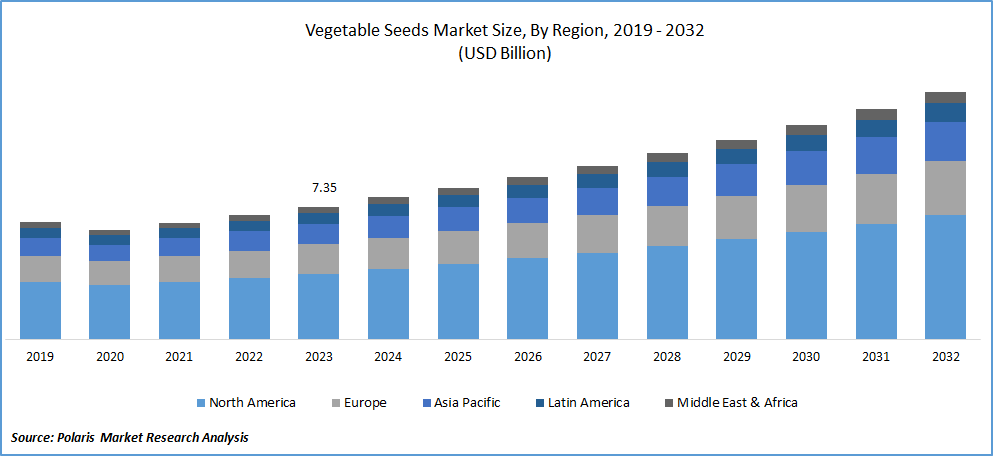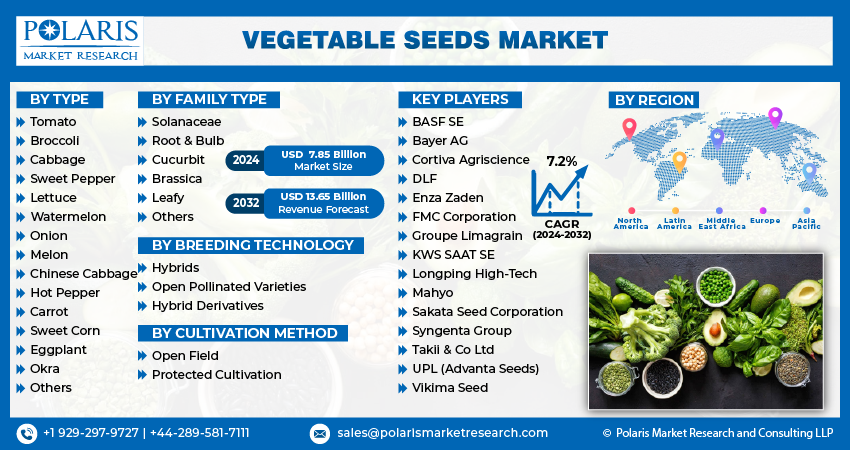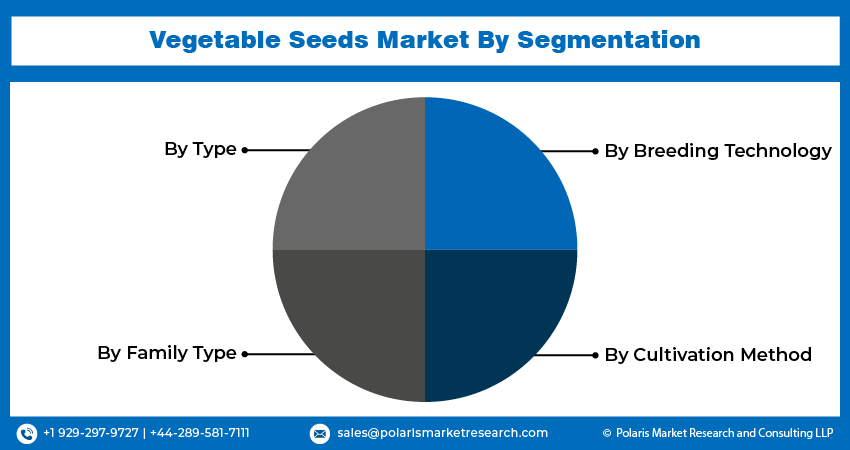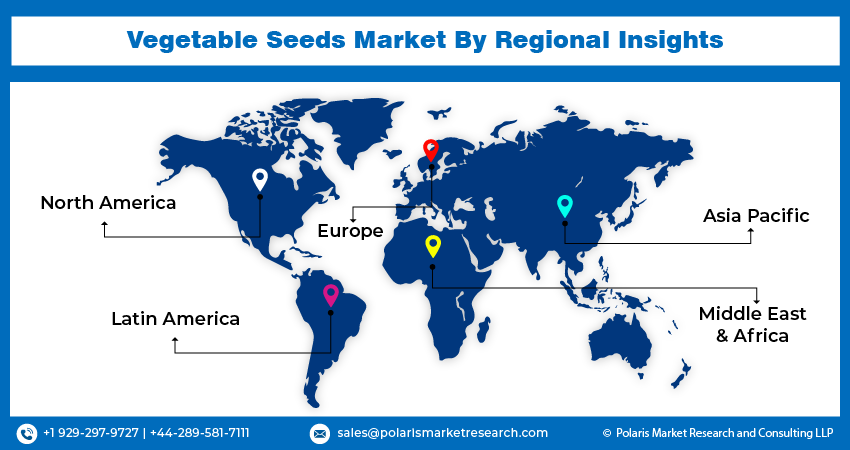
Vegetable Seeds Market Share, Size, Trends, Industry Analysis Report, By Type (Tomato, Broccoli, Cabbage, Sweet Pepper, Lettuce, Watermelon, Onion, Melon, Chinese Cabbage, Hot Pepper, Carrot, Sweet Corn, Eggplant, Okram and Others); By Family Type; By Breeding Technology; By Cultivation Method; By Region; Segment Forecast, 2024- 2032
- Published Date:Mar-2024
- Pages: 118
- Format: PDF
- Report ID: PM4537
- Base Year: 2023
- Historical Data: 2019-2022
Report Outlook
The global vegetable seeds market was valued at USD 7.35 billion in 2023 and is expected to grow at a CAGR of 7.2% during the forecast period.
A balanced diet should include a variety of vegetables, each of which has a unique amount of nutrients. Vegetable-rich diets can help lower the risk of developing any illness or condition, including obesity and eye issues. Eating nutritious, non-starchy greens like spinach, lettuce, and other veggies also aids in weight loss. Thus, the demand for vegetables has been driven by the desire to address a variety of dietary and nutritional needs.
In order to meet the growing demand for veggies, farmers all over the world are requesting premium vegetable planting seeds. The World Health Organization (WHO) estimates that inadequate or nonexistent vegetable consumption contributes to 1.7 million deaths worldwide. One of the top 10 risk factors for world mortality is also a low intake of vegetables.

To Understand More About this Research:Request a Free Sample Report
There is an increasing awareness and preference among consumers for organic and sustainably produced vegetables. Organic vegetable seeds are free from synthetic chemicals and pesticides, aligning with the rising demand for healthier and environmentally friendly food options. The trend of home gardening has gained momentum, with more individuals opting to grow their vegetables. Organic seeds for greenhouse cultivation cater to this growing interest, providing consumers with the means to cultivate organic produce in a controlled environment.
The focus on health and wellness has led to an increased demand for organic vegetables, which are perceived as healthier due to the absence of synthetic chemicals. Companies launching organic vegetable seeds for greenhouses tap into this health-conscious consumer base.
For instance, In September 2021, Bayer announced the introduction of its organic vegetable seeds portfolio, aimed at expanding access to the certified organic market. The initial lineup will concentrate on essential crops tailored for greenhouse and glasshouse cultivation, including tomatoes, sweet peppers, and cucumbers. The commercial launch is scheduled for 2022 in Canada, the United States, Mexico, Spain, and Italy, with the possibility of further expansion in the future.
Furthermore, due to the widespread use of vegetable seeds in various regions, more businesses and governmental organizations are funding intensive research and development projects to assist farmers in achieving the highest crop production outcomes. The global vegetable seeds market is expected to witness remarkable growth potential due to the expanding body of research on a variety of vegetable seeds and the development of hybrid or genetically modified seeds that can withstand climate change.

Industry Dynamics
Growth Drivers
Increasing Population Across the Globe
The increasing population across the globe and their needs increase the market growth. The consequences of urbanization and consumers' increased inclination for organic food products are other factors propelling market expansion. In an effort to boost agricultural productivity, farmers are increasingly turning to genetically modified crops, which is having an impact on the expansion of the hybrid vegetable seeds industry.
Furthermore, the least developed regions of Africa and Asia are seeing potential in the market for hybrid vegetable seeds due to initiatives by organizations like the UN Food and Agriculture Organization (FAO) to attain food security by boosting yields.
Moreover, vegetables provide an efficient supply of nutrients; dietary variety has become increasingly important in terms of health in recent years. Dietary diversification helps ensure that essential micronutrients are supplied in sufficient amounts, balancing the daily intake. This is accomplished by adding veggies, which combat diseases and nutritional shortages. Vegetable consumption is increasing due to this aspect, which is driving up the production of these products. Hence, it is estimated to drive the vegetable seeds market during the forecast period.
Report Segmentation
The market is primarily segmented based on type, family type, breeding technology, cultivation method, and region.
|
By Type |
By Family Type |
By Breeding Technology |
By Cultivation Method |
By Region |
|
|
|
|
|
To Understand the Scope of this Report:Speak to Analyst
By Type Analysis
The Tomato Segment Expected to Witness the Fastest CAGR During the Forecast Period
The tomato segment is expected to witness the fastest CAGR during the forecast period, which is allied to the growing use of tomatoes in a variety of culinary preparations and the growing expenditures made by businesses on R&D to bring in organic seeds that offer superior health advantages.
Tomato production is heavily influenced by consumer demand for tomatoes, both fresh and processed (such as in sauces, ketchup, etc.). Farmers may decide to expand their crops in response to high demand. With the increasing use of tomatoes, demand for tomato seeds is increasing significantly, which shows the largest market growth. Advances in agricultural technology, such as improved seeds, irrigation techniques, and pest control methods, can drive increased tomato production by enhancing efficiency and yield.
Tomatoes contain antioxidants, such as lycopene, vitamin C, and beta-carotene, which can help neutralize harmful free radicals in the body. Antioxidants play a role in reducing the risk of chronic diseases. The lycopene in tomatoes has been linked to cardiovascular health. It may help lower blood pressure, reduce cholesterol levels, and improve overall heart function. The antioxidants in tomatoes may have anti-inflammatory effects, potentially helping to reduce inflammation in the body and alleviate symptoms associated with certain conditions. However, some studies indicate that the antioxidants in tomatoes, particularly lycopene, may have a protective result against specific types of cancers, including prostate, lung, and stomach cancers.
International demand and trade agreements are growing tomato production. Export opportunities may drive increased cultivation due to increasing demand in global markets. This results in a growing vegetable seeds market share.
By Breeding Technolog
The Open-Pollinated Varieties Accounted For the Largest Market Share in 2023
In 2023, the open-pollinated varieties accounted for the largest vegetable seeds market share. Open pollination refers to the natural process of pollination by insects, birds, wind, or human intervention without restrictions on pollen flow between individuals. This method results in greater genetic diversity within crops, allowing them to adapt to local growing conditions and climates.
The prominence of open-pollinated varieties in the market can be attributed to their widespread adoption in developing nations. Furthermore, these varieties are commonly produced in the unregulated market by local farmers and producers. The lack of restrictions facilitates their availability and adoption, contributing to increased market growth.

Regional Insights
Asia-Pacific Dominated the Largest Market Share in 2023
In 2023, Asia-Pacific dominated the largest market share. The Asia-Pacific region has a wide range of climates, from tropical to temperate, making it suitable for the cultivation of a large variety of vegetables. The region is particularly well known for its rich biodiversity, which translates into a large variety of unique and native agricultural varieties that frequently call for specialized seeds. In addition, the vegetable seeds market in China had the most market share, while the market in India had the quickest rate of growth in the Asia-Pacific area.
The North American vegetable seeds market is anticipated to witness significant growth. The vegetable gardening seed industry has been driven by the increased demand for vegetables in the US, Canada, and Mexico. The market in the US is also being helped by the nation's growing need for hybrid tomato, lettuce, and sweet pepper seeds. In addition, the North American market with the biggest market share for vegetable seeds was the United States, while the market in Canada was expanding at the quickest rate.

Key Market Players & Competitive Insights
The vegetable seeds market is characterized by intense competition among key players vying for market share. Companies operating in this sector focus on strategies such as product innovation, strategic collaborations, mergers and acquisitions, and geographic expansions to strengthen their market presence and gain a competitive edge. As the demand for high-quality, disease-resistant, and high-yielding vegetable seeds continues to grow, market players are investing in research and development to introduce new and improved varieties.
Some of the major players operating in the global market include:
- BASF SE
- Bayer AG
- Cortiva Agriscience
- DLF
- Enza Zaden
- FMC Corporation
- Groupe Limagrain
- KWS SAAT SE
- Longping High-Tech
- Mahyo
- Sakata Seed Corporation
- Syngenta Group
- Takii & Co Ltd
- UPL (Advanta Seeds)
- Vikima Seed
Recent Developments
- In July 2023, Syngenta Vegetable Seeds successfully concluded the acquisition of Feltrin Sementes, a prominent Brazilian vegetable seed company catering to smallholder growers and home gardeners in over 40 countries. This strategic move, amid the expanding global vegetable seeds market, allows Syngenta to broaden its portfolio, reinforcing its commitment to delivering comprehensive solutions to growers worldwide.
- In April 2020, Sakata Seed America, completed the acquisition of Vanguard Seed, a U.S.-based lettuce seed company. This strategic move aimed to enhance the company's product offerings by introducing new and innovative lettuce varieties to the market.
Vegetable Seeds Market Report Scope
|
Report Attributes |
Details |
|
Market size value in 2024 |
USD 7.85 billion |
|
Revenue forecast in 2032 |
USD 13.65 billion |
|
CAGR |
7.2% from 2024 – 2032 |
|
Base year |
2023 |
|
Historical data |
2019 – 2022 |
|
Forecast period |
2024– 2032 |
|
Quantitative units |
Revenue in USD billion and CAGR from 2024 to 2032 |
|
Segments Covered |
By Type and By Region |
|
Regional scope |
North America, Europe, Asia Pacific, Latin America, Middle East & Africa |
|
Customization |
Report customization as per your requirements with respect to countries, region, and segmentation. |
FAQ's
Vegetables Seeds Market Size Worth $ 13.65 Billion By 2032.
The top market players in Vegetables Seeds Market Longping High-Tech, Sakata Seed Corporation, BASF SE, Bayer AG, Takii & Co Ltd, Syngenta Group
Asia-pacific is contribute notably towards the Vegetables Seeds Market.
The global vegetable seeds market is expected to grow at a CAGR of 7.2% during the forecast period.
Vegetables Seeds Market report covering key segments are type, family type, breeding technology, cultivation method, and region.
